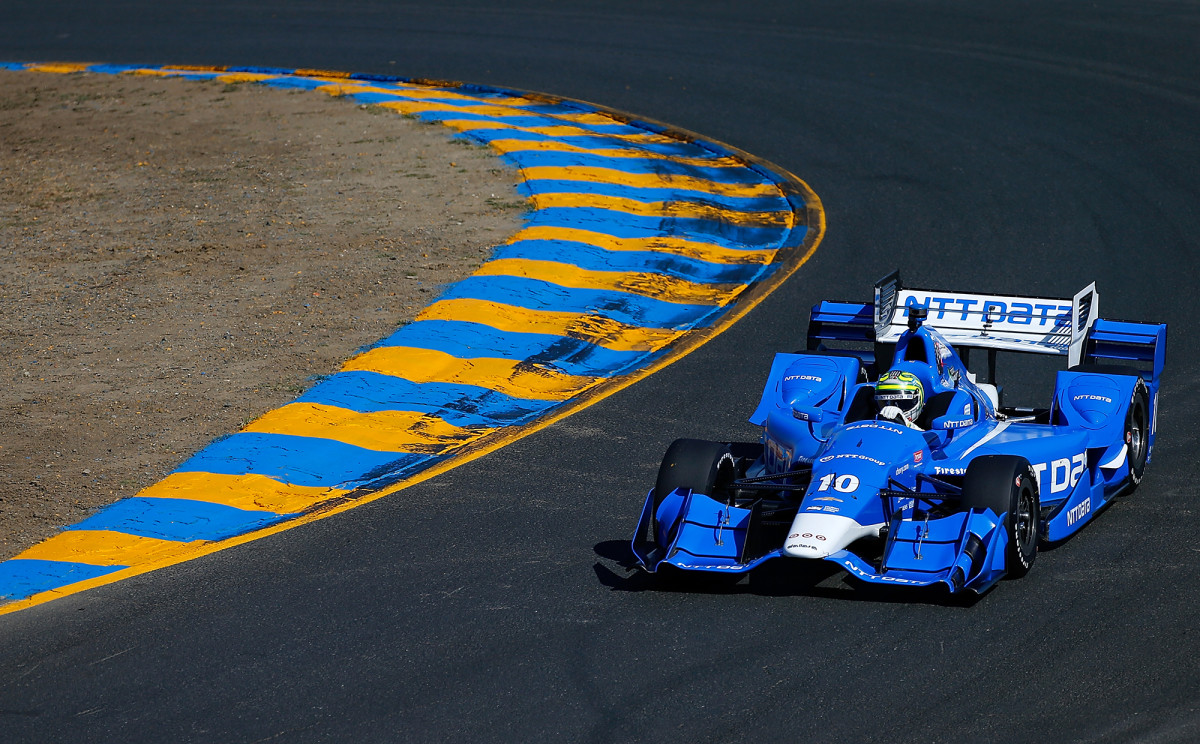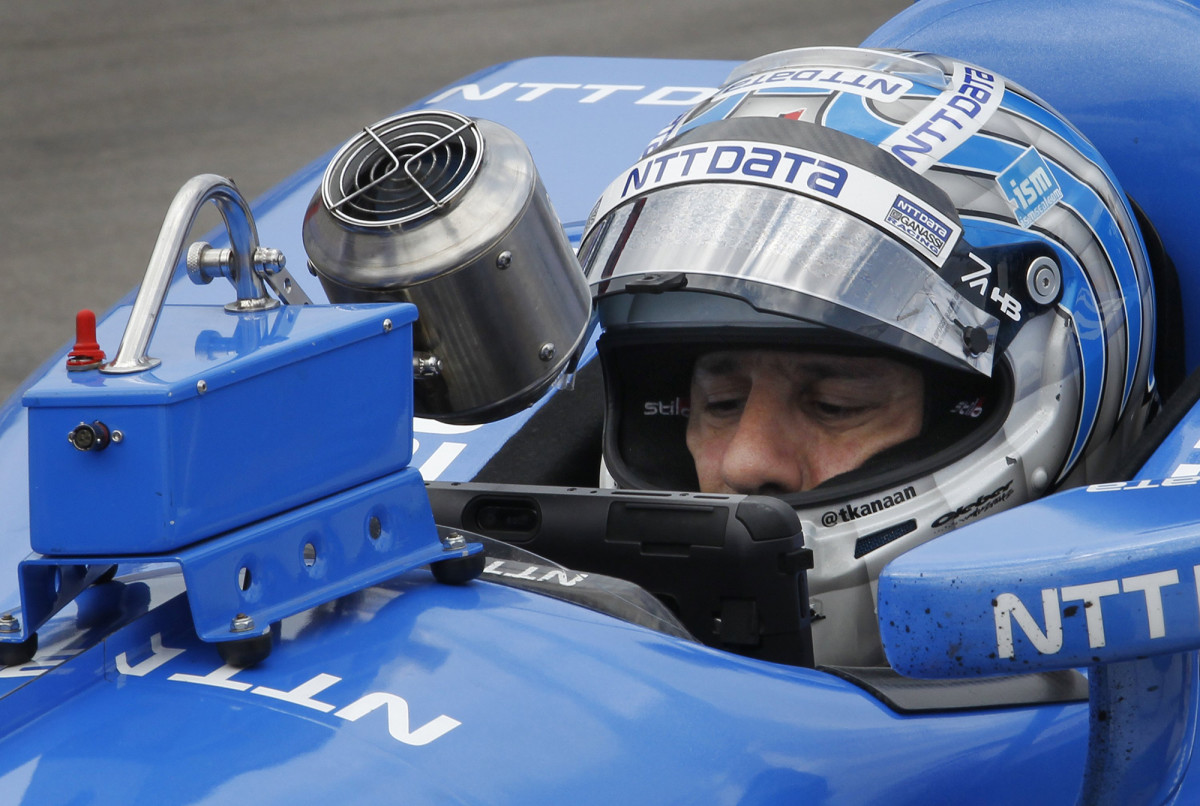IndyCar's Tony Kanaan Is Powered by High-Tech Shirt on the Track

If you were powering around Turn One of the Indianapolis Motor Speedway, you would hold your breath. Because at 230 mph, pulling 2.5 times the force of gravity laterally, in an eight-second blur with 30 other speeding cars, even an IndyCar veteran would hold his breath. Tony Kanaan does.
The 2004 IndyCar Series champion and 2013 Indy 500 winner found that out earlier this year thanks to a smart shirt in development by two Japanese firms, chemical company Toray Industries and IT services company NTT Data. The shirt is a modified version of the fireproof underwear Kanaan wears during races, and has fibers infused with conductive polymers threaded along the right arm and across his chest. (This conductive fabric is branded “hitoe.”) A device that slips into a pocket on the center of his chest collects signals from the fibers—measuring grip strength, breathing and his heart’s ECG trace—and relays this data to NTT through the car’s telemetry system.
What Is it Like to Race Up Some of the Toughest Hills In America On a Bike?
Kanaan started wearing the shirt in 2015, but this past year was the first in which NTT collected a full season’s worth of data. And so it was the first year the team started to get real insight into what Kanaan does inside the car.
“On the ovals, Tony was holding his breath all the way through the corners,” says Brian Welling, an engineer responsible for the radio and data connections on Kanaan’s Chip Ganassi Racing No. 10 car. “Every driver—NASCAR, IndyCar—on all these ovals, they’re probably doing it and they don’t realize.”
The shirt technology has been adapted significantly over the last three years as NTT engineers have learned the nuances of IndyCar racing. Early versions of the shirt had wires that needed to be plugged into the car’s telemetry system, meaning Kanaan had to be hard-wired into the car. Now it wirelessly connects. The signal-collecting device on the shirt had to be moved since it sat right where Kanaan’s seatbelts crossed. And the amount of data—hundreds of data points per second—that needed to be relayed back overwhelmed the bandwidth of the car’s radio and took eight days to analyze. The bandwidth has since been expanded, and analysis is down to less than 24 hours.
Asked about his decades of racing experience up until he started working with sponsor NTT Data, Kanaan, 42, explains, “We had a deficit.” Although everything about the car was measured and scrutinized, “there was no data collection on what the driver would suffer. We never had that.”

“I’ve always worked out my entire life not to be tired in a racecar, but really just guessing what do I do,” Kanaan says. A self-described “workout freak,” he has raced full- and half-Ironman triathlons, and would push his heart rate up above 180 beats per minute in training for IndyCar. He was unsure, though, whether his workouts were optimized for his day job. “Am I preparing in the right way? Am I overdoing? Am I underdoing? Am I doing stuff that I shouldn’t be doing? Am I wasting my time?”
Wearing the hitoe threaded shirt, Kanaan has learned that even on a hard lap his heart rate stays between 130 and 160 beats per minute. He’s worked with his long-time trainer Sergio Alcantara to adjust workouts to focus on that lower heart rate zone. Welling has seen how high stress situations like navigating the pit lane safely affect his driver. “The heart rate really does go up whenever you slow down and come into the pits,” he says.
As well as holding his breath on corners at ovals, Kanaan also grips the steering wheel tighter through the first half dozen laps of every race. When you’re tense you burn more energy, so perhaps finding a way to relax more might improve Kanaan’s endurance through long races. Welling admits, though, that he and the team are still in a learning phase. “None of us are doctors,” he says. “We’re still trying to figure out what we want out of it.”
According to Saurabh Kumar, a software developer at NTT, this shirt represents the “first time in this sport somebody has tried to find correlations between human and machine.”
“[Now] the challenge is to do it real time,” Kumar says. That would mean Kanaan’s physiological data could we merged with his car’s telemetry, and viewed side-by-side on the pit wall. “If we were capable of doing this real time, nothing is impossible.”
According the Mike Thomas, president of the life sciences division at NTT Data Americas, while experimenting with the high-speed world of IndyCar is a good test of the technology, the ultimate focus is to find and develop use cases in health care. The original, non-IndyCar, version of the shirt is designed for medical applications.

Kanaan’s father, Antoine, was diagnosed with cancer when Tony was 11. Tony spent much of the next two years of his childhood watching his dad fight the disease in hospital. Antoine passed away in 1988. Now Kanaan sees this shirt as a way to help other people who might be struggling with cancer or other serious illnesses. Instead of having to stay in hospital, this technology could allow them to be closely monitored at home.
But as far as his fellow IndyCar drivers go, Kanaan would rather be the only one wearing the shirt, “I don’t want them to have it,” Kanaan says. “No way.”
